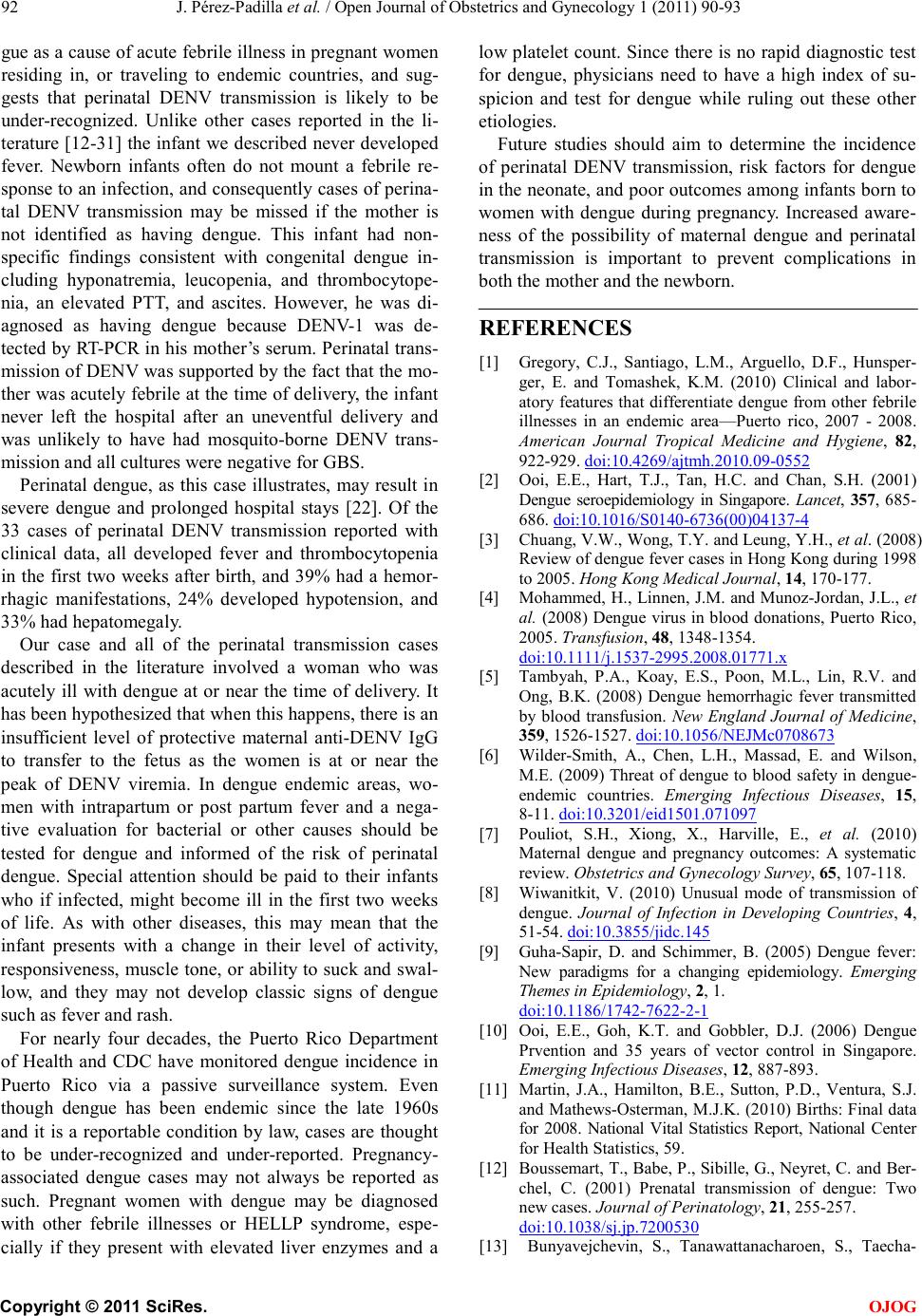
J. Pérez-Padilla et al. / Open Journal of Obstetrics and Gynecology 1 (2011) 90-93
Copyright © 2011 Sci Res. OJOG
gue as a cause of acute febrile illness in pregnant women
residing in, or traveling to endemic countries, and sug-
gests that perinatal DENV transmission is likely to be
under-recognized. Unlike other cases reported in the li-
terature [12-31] the infant we described never developed
fever. Newborn infants often do not mount a febrile re-
sponse to an infection, and consequently cases of perina-
tal DENV transmission may be missed if the mother is
not identified as having dengue. This infant had non-
specific findings consistent with congenital dengue in-
cluding hyponatremia, leucopenia, and thrombocytope-
nia, an elevated PTT, and ascites. However, he was di-
agnosed as having dengue because DENV-1 was de-
tected by RT-PCR in his mothe r ’s serum. Perinata l trans-
mission of DENV was supported by the fact that the mo-
ther was acutely febrile at the time of delivery, the infant
never left the hospital after an uneventful delivery and
was unlikely to have had mosquito-borne DENV trans-
mission and all cultures were negative for GBS.
Perinatal dengue, as this case illustrates, may result in
severe dengue and prolonged hospital stays [22]. Of the
33 cases of perinatal DENV transmission reported with
clinical data, all developed fever and thrombocytopenia
in the first two weeks after birth, and 39% had a hemor-
rhagic manifestations, 24% developed hypotension, and
33% had hepatomegaly.
Our case and all of the perinatal transmission cases
described in the literature involved a woman who was
acutely ill with dengue at or near the time of delivery. It
has been hypothesized that when this happens, there is an
insufficient level of protective maternal anti-DENV IgG
to transfer to the fetus as the women is at or near the
peak of DENV viremia. In dengue endemic areas, wo-
men with intrapartum or post partum fever and a nega-
tive evaluation for bacterial or other causes should be
tested for dengue and informed of the risk of perinatal
dengue. Special attention should be paid to their infants
who if infected, might become ill in the first two weeks
of life. As with other diseases, this may mean that the
infant presents with a change in their level of activity,
responsiveness, musc le tone, or ability to suck and s wal-
low, and they may not develop classic signs of dengue
such as fever and rash.
For nearly four decades, the Puerto Rico Department
of Health and CDC have monitored dengue incidence in
Puerto Rico via a passive surveillance system. Even
though dengue has been endemic since the late 1960s
and it is a reportable condition by law, cases are thought
to be under-recognized and under-reported. Pregnancy-
associated dengue cases may not always be reported as
such. Pregnant women with dengue may be diagnosed
with other febrile illnesses or HELLP syndrome, espe-
cially if they present with elevated liver enzymes and a
low platelet cou nt. Since ther e is no rapid diagnostic tes t
for dengue, physicians need to have a high index of su-
spicion and test for dengue while ruling out these other
etiologies.
Future studies should aim to determine the incidence
of perinatal DENV transmission, risk factors for dengue
in the neonate, and poor outcomes among infants born to
women with dengue during pregnancy. Increased aware-
ness of the possibility of maternal dengue and perinatal
transmission is important to prevent complications in
both the mother a nd the newborn.
REFERENCES
[1] Gregory, C.J., Santiago, L.M., Arguello, D.F., Hunsper-
ger, E. and Tomashek, K.M. (2010) Clinical and labor-
atory features that differentiate d engue from oth er febrile
illnesses in an endemic area—Puerto rico, 2007 - 2008.
American Journal Tropical Medicine and Hygiene, 82,
922-929. doi:10.4269/ajtmh.2010.09-0552
[2] Ooi, E.E., Hart, T.J., Tan, H.C. and Chan, S.H. (2001)
Dengue seroepidemiology in Singapore. Lancet, 357, 685-
686. doi:10.1016/S0140-6736(00)04137-4
[3] Chuang, V.W., Wong, T.Y. and Leung, Y.H., et al. (2008)
Review of dengue fever cases in Hong Kong during 1998
to 2005. Hong Kong Medical Journal, 14, 170-177.
[4] Mohammed, H., Linnen, J.M. and Munoz-Jordan, J.L., et
al. (2008) Dengue virus in blood donations, Puerto Rico,
2005. Transfusion, 48, 1348-1354.
doi:10.1111/j.1537-2995.2008.01771.x
[5] Tambyah, P.A., Koay, E.S., Poon, M.L., Lin, R.V. and
Ong, B.K. (2008) Dengue hemorrhagic fever transmitted
by blood transfusion. New England Journal of Medicine,
359, 1526-1527. doi:10.1056/NEJMc0708673
[6] Wilder-Smith, A., Chen, L.H., Massad, E. and Wilson,
M.E. (2009) Threat of dengue to blood safety in dengue-
endemic countries. Emerging Infectious Diseases, 15,
8-11. doi:10.3201/eid1501.071097
[7] Pouliot, S.H., Xiong, X., Harville, E., et al. (2010)
Maternal dengue and pregnancy outcomes: A systematic
review. Ob st etri cs and Gynecology Survey, 65, 107-118.
[8] Wiwanitkit, V. (2010) Unusual mode of transmission of
dengue. Journal of Infection in Developing Countries, 4,
51-54. doi:10.3855/jidc.145
[9] Guha-Sapir, D. and Schimmer, B. (2005) Dengue fever:
New paradigms for a changing epidemiology. Emerging
Themes in Epidemiology, 2, 1.
doi:10.1186/17 42-7622-2-1
[10] Ooi, E.E., Goh, K.T. and Gobbler, D.J. (2006) Dengue
Prvention and 35 years of vector control in Singapore.
Emerging Infectious Diseases, 12, 887-893.
[11] Martin, J.A., Hamilton, B.E., Sutton, P.D., Ventura, S.J.
and Mathews-Osterman, M.J.K. (2010) Births: Final data
for 2008. National Vital Statistics Report, National Center
for Health Statistics, 59.
[12] Boussemart, T., Babe, P., Sibille, G., Neyret, C. and Ber-
chel, C. (2001) Prenatal transmission of dengue: Two
new cases. Journal of Per inatol o gy, 21, 255-257.
doi:10.1038/sj.jp.7200530
[13] Bunyavejchevin, S., Tanawattanacharoen, S., Taecha-